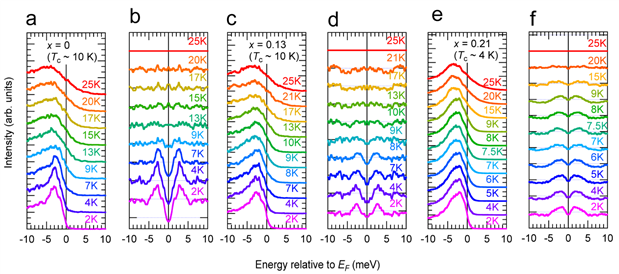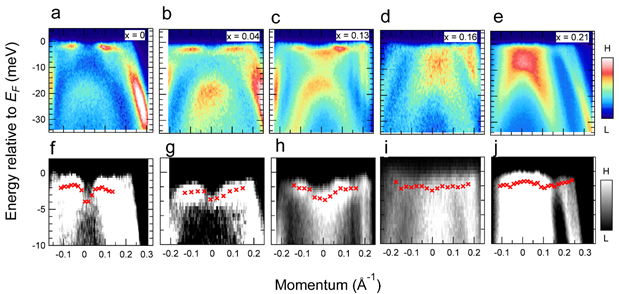These lines show the temperature a sample must reach (10 kelvins) to exhibit superconducting behavior. (Image Credit: 2020 Okazaki et al.)
Superconductors, a material that allows electricity to flow through it with absolutely no resistance, could be very beneficial for future electronics. For the first time, researchers from the University of Tokyo in Japan found a way to create a superconductor from Bose-Einstein Condensate (BEC).
The commonly known states of matter are solids, liquids, gases, and plasmas. The fifth and lesser-known one, Bose-Einstein Condensate, occurs when a gas of bosons are cooled down to near absolute zero. Experiments have exhibited that quantum phenomena can be studied at a macroscopic scale. Previously, scientists have used BECs as a basis to create exotic states of matter such as supersolids, excitonium, quantum ball lightning, and fluids with negative mass.
"A BEC is a unique state of matter as it is not made from particles, but rather waves," said Associate Professor Kozo Okazaki from the Institute for Solid State Physics at the University of Tokyo. "As they cool down to near absolute zero, the atoms of certain materials become smeared out over space. This smearing increases until the atoms — now more like waves than particles — overlap, becoming indistinguishable from one another. The resulting matter behaves like it's one single entity with new properties the preceding solid, liquid or gas states lacked, such as superconduction. Until recently, superconducting BECs were purely theoretical, but we have now demonstrated this in the lab with a novel material based on iron and selenium (a nonmetallic element)."
In their new study, the Tokyo researchers have demonstrated superconductivity in a BEC, which was never confirmed in previous experiments. This was accomplished by producing a BEC out of a cloud of iron and selenium atoms.
The team turned to overlapping BEC with the Bardeen-Cooper-Schrieffer (BCS) regime to verify BEC's superconductivity. Similar to BECs, BCS regimes are produced when clouds of atoms are cooled down to near absolute zero, causing the atoms to slow down and line-up. This allows electrons to pass through without any resistance.
The team observed how electrons (red crosses) behaved under varying circumstances, which revealed a smooth conversion from BEC to BCS superconductivity regime. (Image Credit: 2020 Okazaki et al.)
"Demonstrating the superconductivity of BECs was a means to an end; we were really hoping to explore the overlap between BECs and BCSs," said Okazaki. "It was extremely challenging, but our unique apparatus and method of observation has verified it — there is a smooth transition between these regimes. And this hints at a more general underlying theory behind superconduction. It is an exciting time to be working in this field."
The team used ultra-low temperature and high-energy laser-based photoemission spectroscopy to observe how the electrons behaved while a material transitioned from BCS to BEC. Even though electrons behaved differently in both regimes, the overlap allowed the team to observe superconductivity in a BEC.
This discovery doesn't have any public applications, but understanding the phenomenon on a deeper level could help researchers develop better superconductors in the future.
"With conclusive evidence of superconducting BECs, I think it will prompt other researchers to explore superconduction at higher and higher temperatures," said Okazaki. "It may sound like science fiction for now, but if superconduction can occur near room temperature, our ability to produce energy would greatly increase, and our energy needs would decrease."
Have a story tip? Message me at: http://twitter.com/Cabe_Atwell



Top Comments
-

DAB
-
Cancel
-
Vote Up
+1
Vote Down
-
-
Sign in to reply
-
More
-
Cancel
-

jipilabont
in reply to DAB
-
Cancel
-
Vote Up
0
Vote Down
-
-
Sign in to reply
-
More
-
Cancel
-

DAB
in reply to jipilabont
-
Cancel
-
Vote Up
0
Vote Down
-
-
Sign in to reply
-
More
-
Cancel
-

jipilabont
in reply to DAB
-
Cancel
-
Vote Up
0
Vote Down
-
-
Sign in to reply
-
More
-
Cancel
-

DAB
in reply to jipilabont
-
Cancel
-
Vote Up
0
Vote Down
-
-
Sign in to reply
-
More
-
Cancel
Comment-

DAB
in reply to jipilabont
-
Cancel
-
Vote Up
0
Vote Down
-
-
Sign in to reply
-
More
-
Cancel
Children